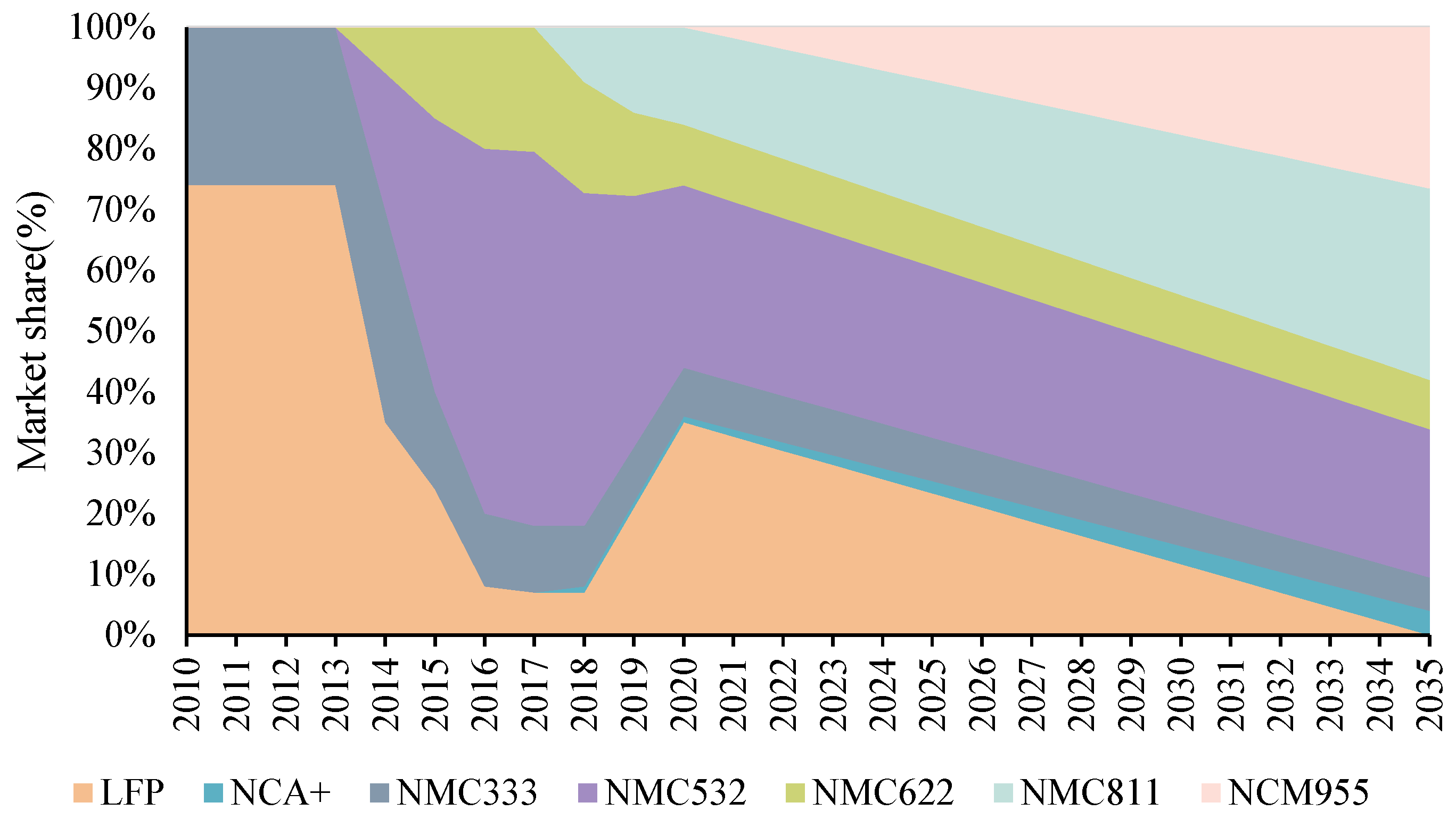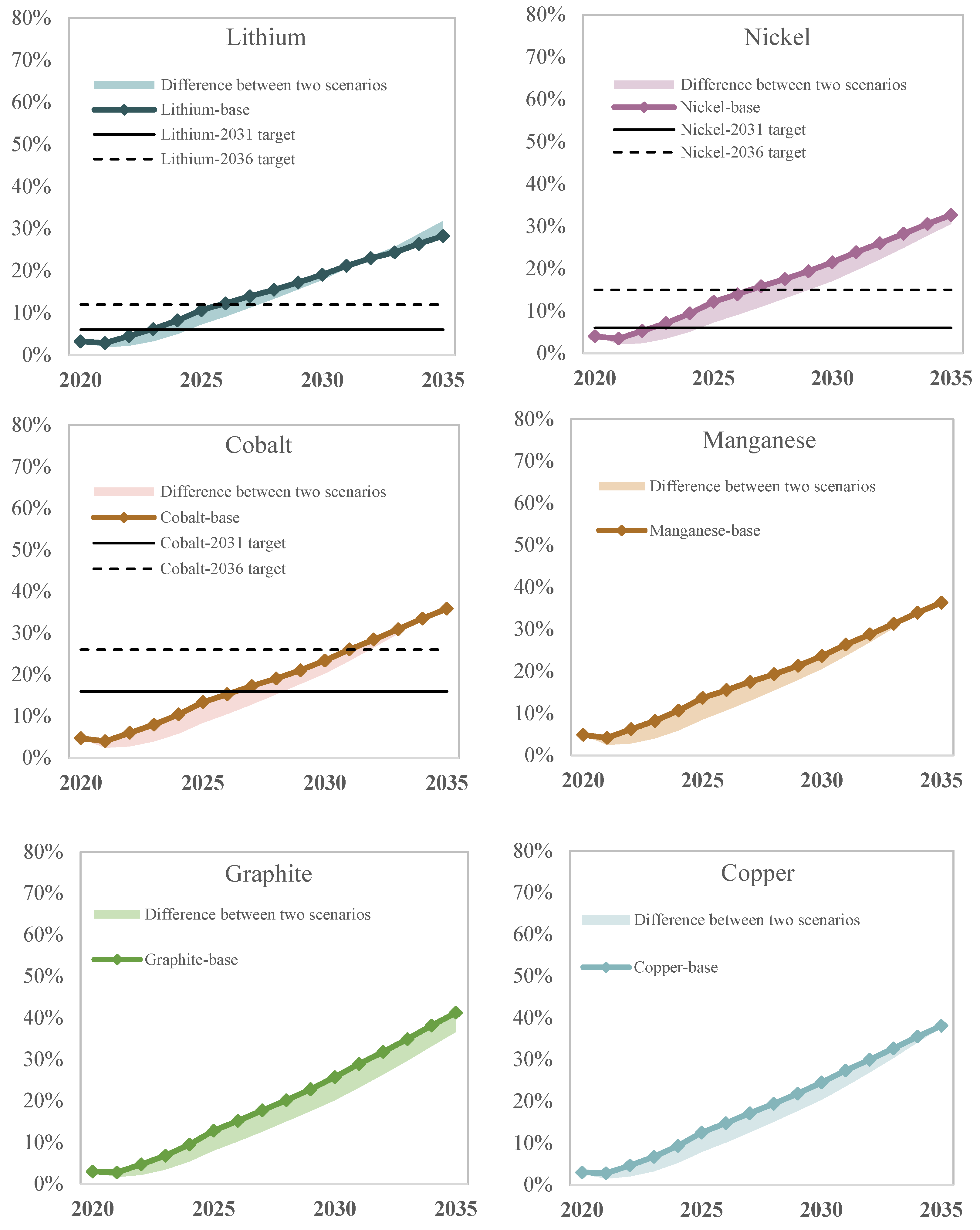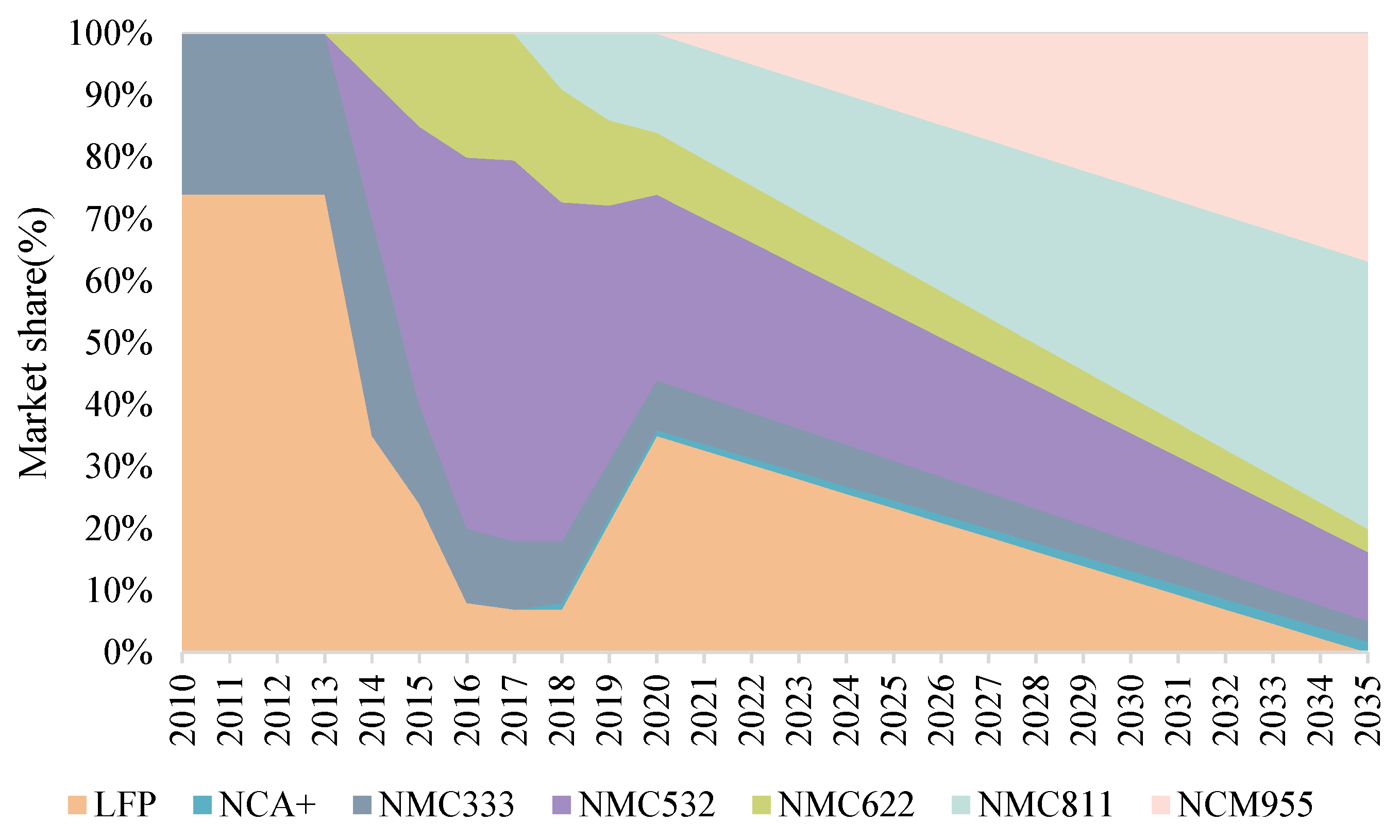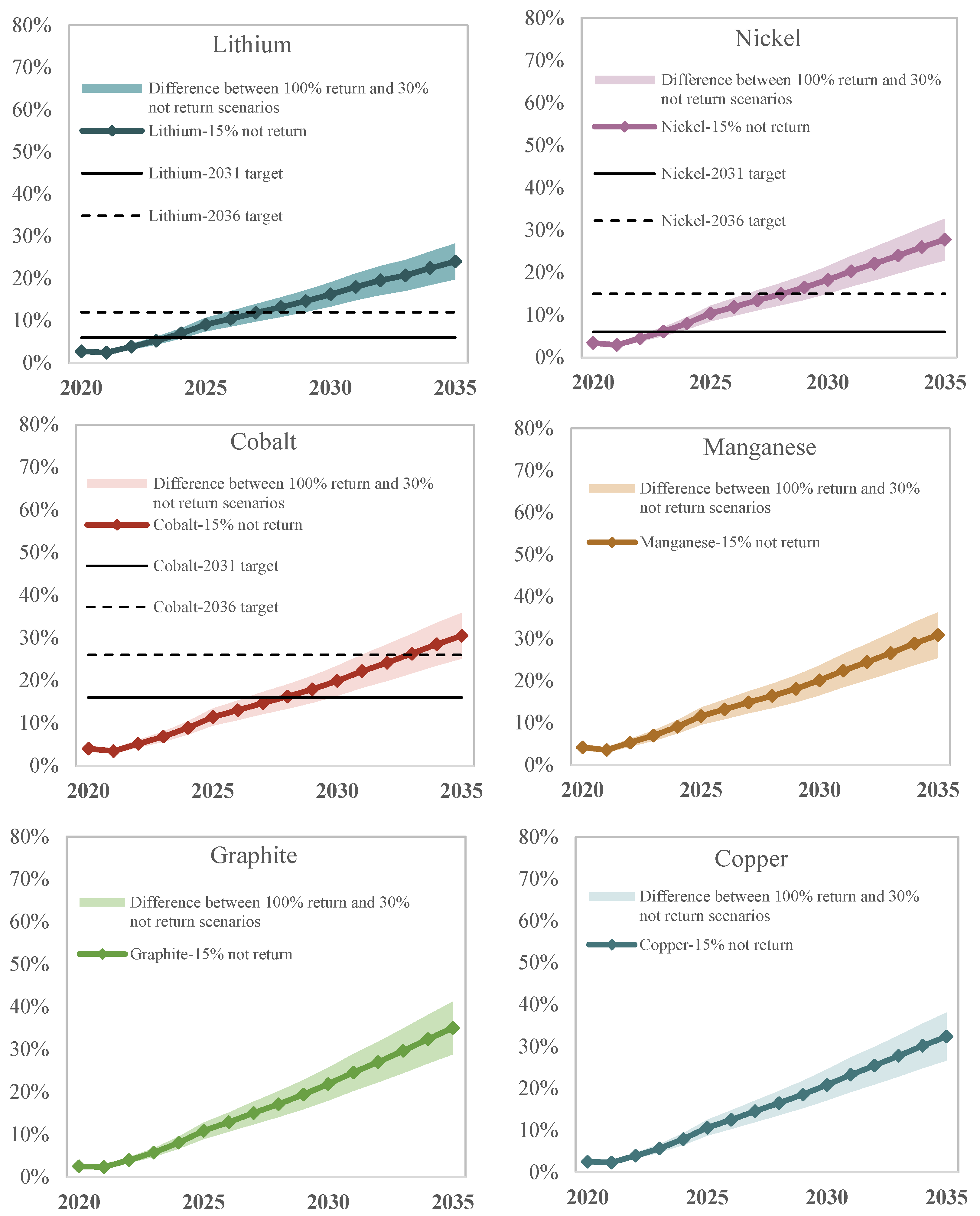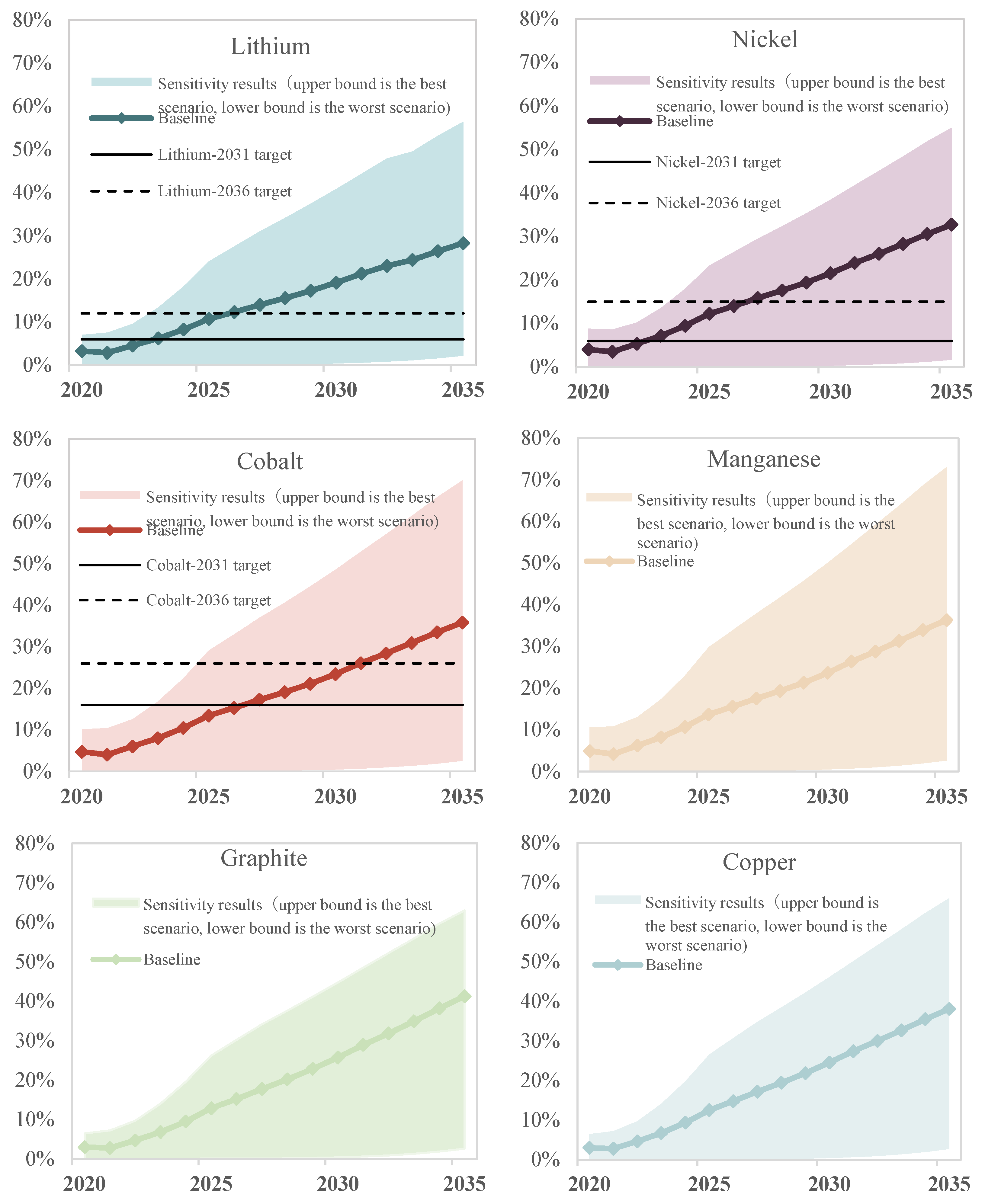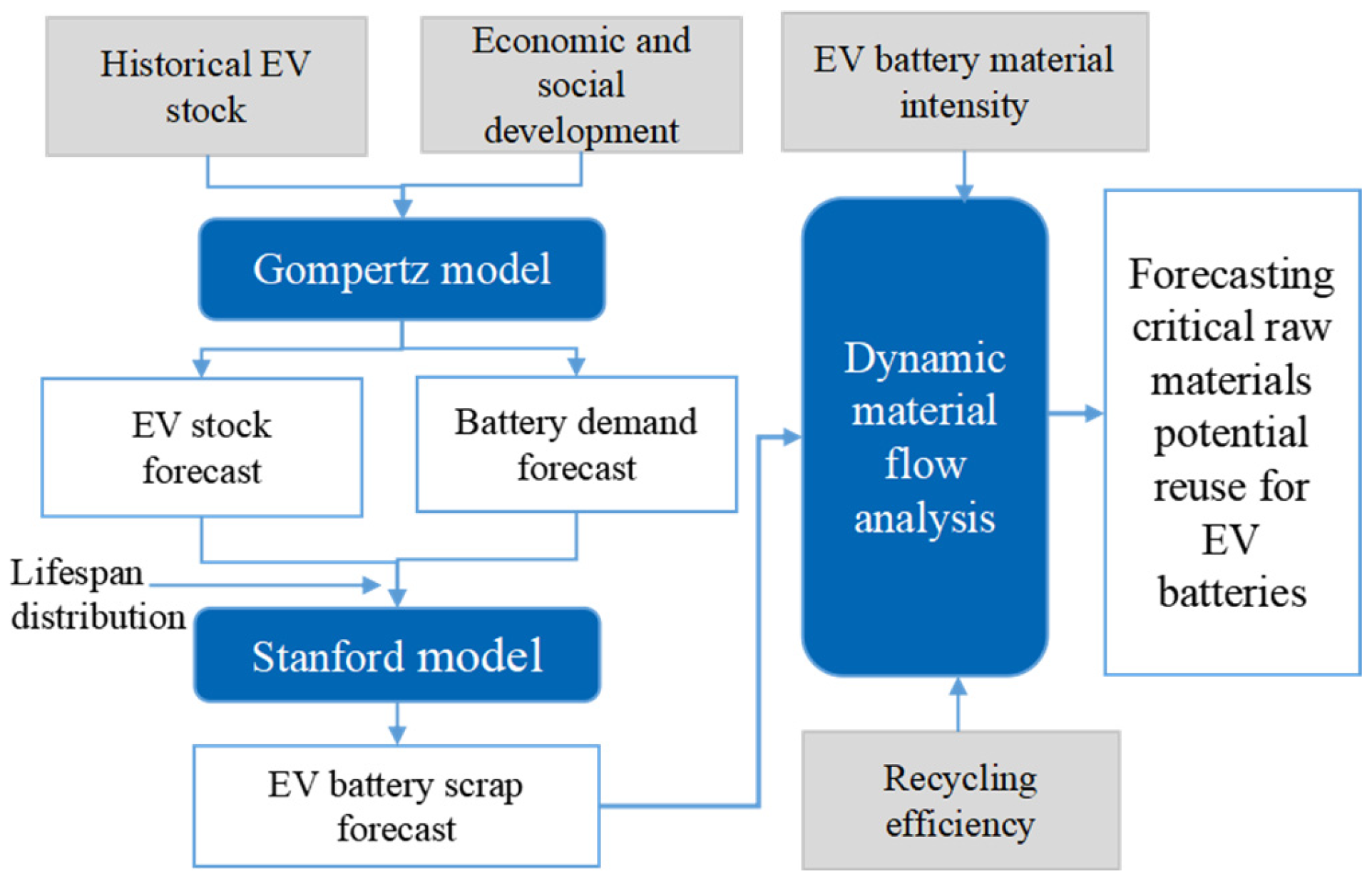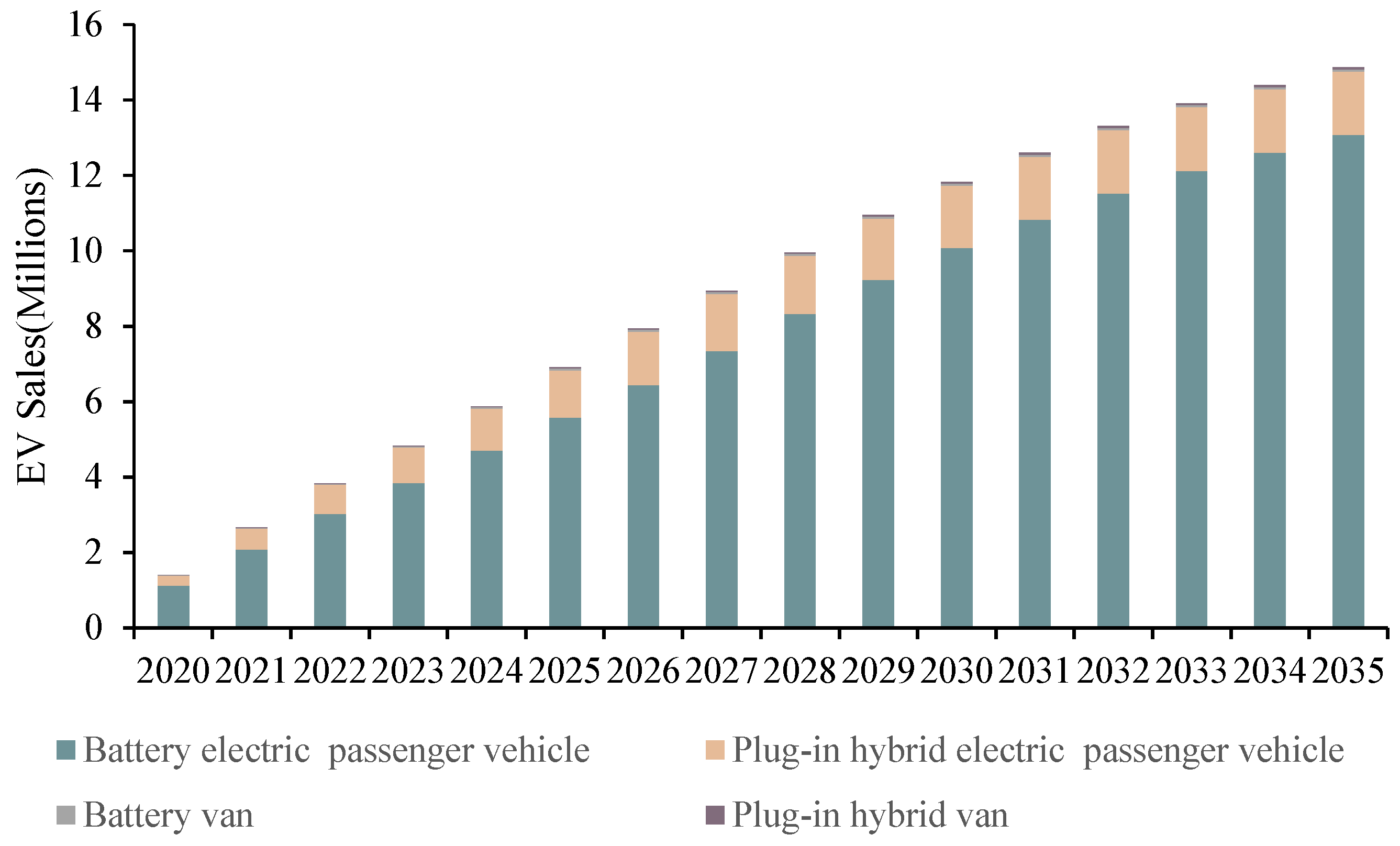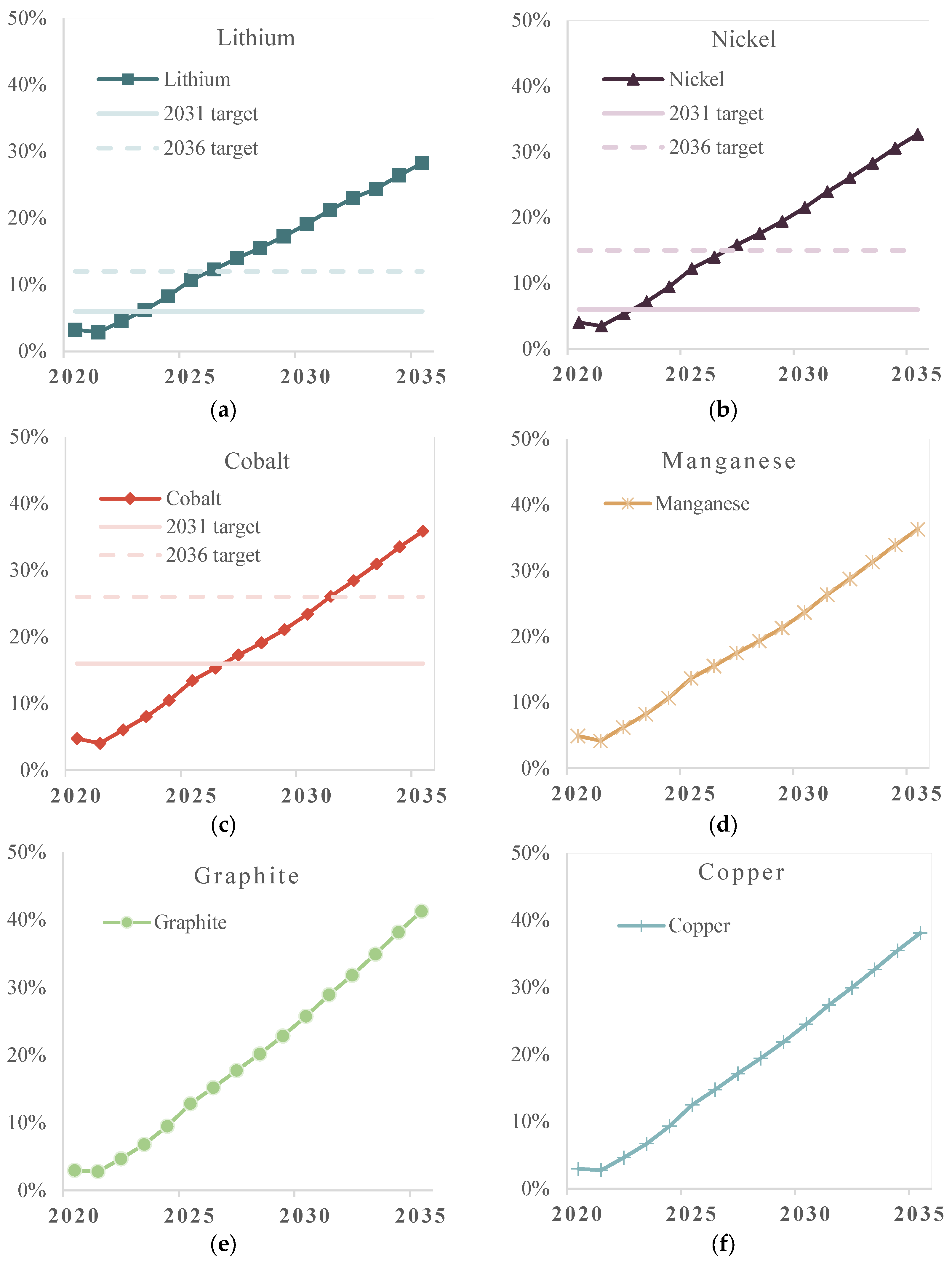1. Introduction
The market for electric vehicles (EVs) is experiencing continuous growth, resulting in increased demands for both materials and capacity in the production of EV batteries [
1,
2]. Concurrently, the increasing demand for raw materials has prompted the search for alternative materials. The recycling and reuse of battery materials present a promising option [
3], and the European Union (EU) put forward a new regulatory framework for batteries on 28 July 2023, which would be enacted on 17 August 2023. The EU Batteries Regulation introduces EU-wide mandatory sustainability and information requirements for all batteries placed on the European market, targeting the entire battery life cycle [
4]. Key provisions include the minimum percentage share of lithium, nickel, cobalt, and lead, carbon footprint statements, due diligence rules, and minimum material recovery efficiencies [
5]. The regulation sets minimum thresholds of recycled materials for new EV batteries: 16% cobalt, 6% lithium, and 6% nickel by 2031, with increased targets of 26% cobalt, 12% lithium, and 15% nickel by 2036.
The EU represents the principal export market for EVs from China [
6,
7]. Therefore, compliance with the targets set forth in the EU Batteries Regulation is a prerequisite for the export of Chinese EVs to the EU. Meanwhile, the earlier development of EVs in China, coupled with the impending peak in retirement, has provided a sufficient supply of raw materials for recycled materials, thereby positioning China with increased potential to achieve the targets established by the EU Batteries Regulation. The growth of China’s EV sector has been remarkable since 2010. In 2023, the sales volume of EVs in China surpassed 9.5 million [
8], while EV batteries experienced significant growth as well, with the annual cumulative installed capacity achieving 387.7 GWh [
9]. Based on the calculation of battery lifespan [
10], over 1.3 million EVs sold prior to 2018 have entered their decommissioning phase. A substantial number of retired EVs present valuable resources for the recovery of materials utilized in the production of EV batteries.
The destinations of retired EV batteries primarily include secondary utilization and recycling. Secondary utilization refers to repurposing end-of-life (EoL) batteries for a second life in electric power systems. This approach not only aids in balancing supply and demand within the power grid but also enhances the overall value derived from battery facilities [
11]. Research on battery recycling can be categorized into three main areas. The first concerns the retirement of EV batteries, focusing on the volume and spatial distribution of retired batteries. For instance, Richa et al. [
12] estimated the waste flows of lithium-ion batteries (LIBs) in the United States, projecting that between 0.33 and 4 million tons of waste LIBs would be generated from 2015 to 2040, of which only 42% is currently recycled. Furthermore, regional disparities in resource distribution have been examined; Jiang et al. [
13] assessed EV battery waste flows in China, finding that supply is concentrated along the eastern coast, whereas demand is predominantly located in western inland regions. Collectively, these studies indicate a growing volume of retired EV batteries, establishing them as an increasingly important resource. The second research category addresses recycling rates, including battery collection and material recovery efficiencies. Song et al. [
14] reported that under current material flow frameworks in China, less than 40% of materials from LIBs are recycled. Furthermore, Zhang et al. [
15] and Shi [
16] identified that China’s existing production capacity and reserves of primary nickel and cobalt are insufficient to meet escalating demand; however, closed-loop nickel recovery from EV batteries could effectively alleviate this supply–demand imbalance. Although recycling rates remain suboptimal, they contribute positively to creating a circular material economy. The third area focuses on the proportion of recycled materials incorporated into new EV batteries. Kamran et al. [
17] demonstrated that recycling EoL EV battery packs substantially facilitates “closing the loop”. Globally, Tankou et al. [
18] estimated that efficient recycling of EoL batteries could reduce the combined annual demand for newly mined lithium, cobalt, nickel, and manganese by 3% in 2030, 11% in 2040, and up to 28% in 2050. Meanwhile, Bruno and Fiore [
19] found that while European production plants have sufficient capacity to meet projected 2030 needs, the treatment capacity of European recycling facilities would only supply approximately 2% of the materials required for LIB production in that year. These findings suggest that the proportion of recycled materials in EV batteries is influenced not only by regional retirement volumes but also by factors such as the recycling capacity of processing plants and broader industrial infrastructure.
In the studies of the factors influencing the recycled material content in EV batteries, a substantial body of research has identified battery lifespan as a critical determinant. Additionally, several studies have considered the impact of material recycling potential, battery technology development, recycling efficiency, and battery demand. For example, Kalmykova et al. [
20] assert that the distribution of battery lifespan is vital for accurately estimating the total generation of waste batteries. Similarly, Jiang et al. [
13] demonstrate that battery lifespan significantly influences the supply of recycled materials within Chinese EV batteries. Other influencing factors are also be considered. Arshad et al. [
21] consider the recycling efficiency of retired EV batteries affects the application effect of recycled materials. Zhang et al. [
15] highlight the significance of low-nickel battery technology and recycling efficiency of retired EV batteries as essential for the sustainable growth of the EV industry and the availability of nickel resources in China. Furthermore, according to Abdelbaky et al. [
22], uncertainties surrounding the rapidly evolving material compositions of EV batteries, alongside the potential commercialization of cobalt-free battery technologies, are two factors affecting the recycling waste stream of EV batteries in the EU. Hoarau and Lorang [
23] indicate that the proportion of recycled materials in the newly built EV batteries in the target year is not sensitive to the change in factors such as material recovery efficiency, EV battery demand, and material strength change caused by battery technology development. Additional, Xia and Li [
24] contend that optimizing the power structure, upgrading battery technology, and improving the recycling efficiency are of great significance for the large-scale promotion of EVs, closed-loop production of batteries, and sustainable development of the resources, environment, and economy.
Therefore, a gap exists in the analysis focusing on the content and influencing factors of recycled materials in EV batteries, particularly from the standpoint of achieving targets associated with EV exportation. This is because most existing studies have been conducted primarily from the perspective of domestic industrial development. To fill this gap, a Chinese EV recycled materials use potential analysis model has been developed. This model assesses the maximum material waste flow of lithium, cobalt, nickel, manganese, graphite, and copper derived from retired EV batteries in China in the target year, as well as the forecasted demand for these six materials within China’s EV battery industry during the same timeframe. Additionally, a sensitivity analysis of the factors influencing the maximum proportion of recycled materials (MPRMs) has been conducted. The objectives of the paper were to (1) assess the size of China’s retired EV battery reserves available for future EV battery manufacturing; (2) identify key risk factors that affect the MPRMs and, in turn, influence the export of Chinese-made EVs to the EU; (3) propose policy recommendations to facilitate the export of EVs to the EU.
The main contributions of this paper are as follows: First, it enriches the understanding of EV battery recycling and regulatory assessment by incorporating Chinese experience. Building upon existing simulation and evaluation frameworks of the EU Batteries Regulation [
25], this study develops a Chinese EV recycled materials use potential analysis model and evaluates the EV recycled materials use potential situation in China, thereby providing a valuable region-specific perspective. Second, it offers strategic insights for industry stakeholders. By forecasting the future development trajectory of EV batteries in China, the study supports enterprises across the Chinese EV battery value chain in formulating informed strategic plans. Third, it informs policymaking and promotes sustainable development. This study investigates the forecasted share of recycled materials and associated influencing factors in China’s EV batteries, thereby furnishing empirical support for policymakers in designing effective regulations for battery recycling and utilization. Moreover, these efforts contribute to advancing Sustainable Development Goals [
26].
The remaining parts are arranged as follows:
Section 2 discusses the methods and data, introducing the methods and data to assess the MPRMs in the EV batteries in China in the target year.
Section 3 presents the benchmark analysis, which discusses the forecast results in the baseline scenario.
Section 4 provides a sensitivity analysis of influencing factors, including battery lifespan, EV battery demand, EV battery technology development, EV battery collection rate, and EV battery reshoring, that may affect the MPRMs.
Section 5 concludes with findings and policy recommendations.
3. Baseline Analysis
This section shows the baseline results of the constructed model. It focuses on the forecasting of the MPRMs in new EV batteries up to 2035. This section clearly shows the MPRMs of lithium, cobalt, nickel, manganese, graphite, and copper in the target years, with the EV battery lifespan of 10 years.
In the baseline scenario, the forecasted results of the MPRMs in EV batteries manufactured in China in the target year are shown in
Figure 3. The results show that the evolutions of the MPRMs of lithium, nickel, cobalt, manganese, graphite, and copper are increasing between 2020 and 2035. It indicates that the amount of available EV batteries that can get recycled grows faster than the demand in new EV batteries. Among the six kinds of recycled materials, the MPRM of nickel is the lowest and has the smallest increase among the six raw materials by 2035. The MPRMs among the six materials required to manufacture EV batteries in 2031 and 2035 are shown in
Table 1.
Table 1 indicates that by 2031, the MPRMs of six kinds of materials are forecasted to exceed 20%. Specifically, the MPRM of graphite is the highest, with a proportion of 28.9%, while the MPRM of lithium is the lowest, with a proportion of 21.2%. By 2035, the lowest MPRM is lithium, with a proportion of 28.3%, whereas the highest MPRM is graphite, with a proportion of 41.3%. Notably, the MPRMs of the six kinds of materials are exceeding 28% by 2035.
In the baseline scenario, the MPRMs in EV batteries manufactured in China for the target years significantly surpass the targets stipulated in the EU Batteries Regulation, which specifies minimum thresholds of 6% for lithium, 6% for nickel, and 16% for cobalt by 2031, and 12% for lithium, 15% for nickel, and 26% for cobalt by 2036. Consequently, Chinese enterprises are well positioned to meet the minimum percentage of CRMs outlined in the EU Batteries Regulation.
This forecasting result is higher than the global result assessed by Tankou et al. [
18], where the competitive advantages enjoyed by enterprises in China can primarily be attributed to supportive governmental policies, the earlier development of EV industry, and the adoption of hydrometallurgical processes. Firstly, China’s EV industry developed early and rapidly, surpassing the sales volume of EVs in the EU. In 2023, the sales volume of EVs in the EU was 1.5 million [
63] while the EV sales volume in China was 9.5 million [
8], nearly six times as many as in the EU. A large amount of continuously growing demand for EVs will bring more retired EV batteries to China than the EU in 8 to 10 years and provide sufficient raw materials for acquiring recycled materials. Secondly, China’s battery recycling industry developed earlier and formulated a series of policies to facilitate the industry’s further standardized development and growth. China has fostered the standardized development of the recycling industry through the implementation of various policies, such as the industry-standard conditions for the comprehensive utilization of retired power batteries of new energy vehicles [
61] and Interim Measures for the Management of Recycling and Utilization of Traction Batteries for New Energy Vehicles (exposure draft) [
64]. These policies regulate the development of the recycling market and further enhance the material recovery levels for retired EV batteries. Thirdly, the hydrometallurgical process, which was adopted by China, demonstrates advantages over traditional pyrometallurgical methods, including a higher recovery level, higher purity of recovered products, and the ability to recover a larger fraction of battery components. These attributes render hydrometallurgy an ideal method for the recycling of waste EV batteries. In China, compliant enterprises are authorized to employ the hydrometallurgical process for metal extraction. By enforcing compliance policies, China facilitates an increased flow of waste EV batteries into compliant enterprises. These dual effects not only augment the metal material recovery level from waste EV batteries but also ensure the viability of compliant recycling enterprises, consequently expanding the industry’s scale. As the industry’s scale increases, a greater volume of waste EV batteries can be processed via hydrometallurgical techniques, leading to an overall improvement in the recovery level of metal materials.
4. Sensitivity Analysis
This section presents the results of sensitivity analyses. To identify the key risk factors that may influence the MPRMs in new EV batteries, and that influence the exportation of EVs made in China to the EU, analyses of the relevant influencing factors were conducted. The factors under consideration include battery lifespan, battery demand, battery technology development, battery collection rate, and battery reshoring on MPRMs. In 2023, China exported 1.2 million EVs, which accounted for about 13% of the total EV sales. With the development of China’s EV industry, it is anticipated that the proportion of EV exports will increase further. However, if the exported EV batteries cannot be returned to China after use, this will adversely impact the supply of raw materials for new EV batteries, thereby affecting the MPRMs in the new EV batteries in the target year. As a leading exporter of EVs and EV batteries globally, China’s export volume of EV batteries is expected to rise in response to increased global demand for EVs. Nevertheless, many exported EV batteries will face restrictions related to the import of battery scrap and waste batteries as outlined in the “Catalogue of Ban Imports of Solid Waste (2020/53)” [
65] following their retirement. Consequently, certain EV batteries sold abroad may not be subject to effective closed-loop recycling management upon their retirement. Therefore, it is essential to consider the factor of EV batteries reshoring.
4.1. Battery Lifespan
In the research of the MPRMs in EV batteries in China, a sensitivity analysis to assess the impact of battery lifespan on the MPRMs has been conducted. The lifespan of EV batteries in China is estimated to be 6 years, 10 years, and 14 years, respectively. The 14-year lifespan simulates a scenario where EV batteries are used for second-life utilization after their initial retirement. Detailed results are shown in
Table 2.
When the battery lifespan is 6 years, the MPRMs of lithium, nickel, cobalt, manganese, graphite, and copper are forecasted to be 35.7%, 35.0%, 40.6%, 41.1%, 40.2%, and 41.3% in 2031, respectively. Moreover, in 2035, the MPRMs of these materials are expected to increase to 46.2%, 46.4%, 53.6%, 54.3%, 52.9%, and 54.9%, respectively. Conversely, when the battery lifespan is extended to 14 years, the MPRMs of lithium, nickel, cobalt, manganese, graphite, and copper drop significantly, yielding values of 4.8%, 3.6%, 6.0%, 6.4%, 4.9%, and 5.0% in 2031, respectively. In 2035, these values are anticipated to rise slightly to 12.8%, 9.4%, 15.0%, 15.6%, 15.1%, and 15.6%, respectively. These results indicate an inverse relationship between battery lifespan and MPRMs; specifically, shorter lifespans correspond to higher MPRM values. The evolutions of MPRMs over time are displayed in
Figure 4.
Figure 4 illustrates the impact of battery lifespan on the MPRMs of the six types of recycled materials. The solid lines represent the MPRMs of materials within the baseline scenario, wherein the battery lifespan is assumed to be 10 years. The shaded parts are the influences of battery lifespan on the MPRMs, the horizontal solid lines represent the minimum thresholds of recycled materials for the new batteries to be manufactured in the EU Batteries Regulation for 2031, and the dashed lines represent the minimum thresholds of recycled materials for the new batteries to be manufactured in the EU Batteries Regulation for 2036. In comparison to the EU Batteries Regulation targets for the proportion of recycled materials in EV batteries, it is evident that EV batteries manufactured in China may fulfill the requisite standards when the battery lifespan is either 6 or 10 years. However, under an extended lifespan of 14 years, compliance is only partially achieved. Specifically, the MPRM of lithium only meets the target in 2036, whereas the MPRMs for nickel and cobalt fall short of the thresholds mandated by the EU Batteries Regulation. This analysis underscores the crucial role of battery lifespan in determining the MPRMs of CRMs in EV batteries produced in China, which, in turn, has significant implications for the export of these batteries to the EU. Such findings may hinder initiatives aimed at prolonging battery lifespan, such as second-life utilization. In the context of a 14-year lifespan, retired EV batteries undergo a reuse process post-decommissioning. While second-life utilization has the potential to enhance economic returns and mitigate environmental pollution associated with battery disposal, it may simultaneously impede the realization of sustainability objectives related to battery material recycling. Consequently, this situation could adversely affect the export viability of Chinese-made EV batteries to the EU.
4.2. Battery Demand
To analyze the influence of EV battery demand on the MPRMs, we developed a Sustainable Development Scenario (SDS) by tripling the forecasted sales in the target years. This scenario assumes an increased demand for EV batteries, and the details are presented in
Table A3.
In the SDS, the MPRMs of lithium, nickel, cobalt, manganese, graphite, and copper are forecasted to be 20.6%, 19.6%, 23.4%, 23.8%, 23.3%, and 23.9% in 2031, respectively. Furthermore, the MPRMs of these materials could reach 31.9%, 30.6%, 37.0%, 37.6%, 36.8%, and 38.2% by 2035, respectively. In both the baseline scenario and the SDS, upward trends in all MPRMs are evident. This observation suggests that the available waste flow is increasing at a rate that surpasses the material demand for new EV batteries in the target year, despite an overall increase in demand for new EV batteries. Additionally, in the SDS, the MPRMs except lithium are lower than those forecasted in the baseline scenario. The evolutions of the MPRMs under two scenarios are illustrated in
Figure A2.
Figure A2 illustrates the results of a sensitivity analysis regarding the impact of EV battery demand on the MPRMs. The curves with diamonds represent the MPRMs under the baseline scenario. The shaded areas in the figure represent the influence scales of battery demand. Moreover, the results indicate that in the SDS, the MPRMs of lithium, cobalt, and nickel continue to satisfy the EU Batteries Regulation targets for minimum thresholds of recycled materials required for the manufacture of new batteries. The comparative analysis shows that the differences in MPRM values across the two scenarios are minimal, suggesting that the MPRMs of all six materials are capable of meeting the EU targets in both scenarios. Consequently, the findings imply that the effect of battery demand on the MPRMs of six kinds of materials in EV batteries produced in China is relatively modest. Therefore, it can be inferred that battery demand does not significantly influence the export of Chinese-manufactured EVs to the EU.
4.3. Battery Technology Development
The increasing inclusion of nickel is a key trend in the technological development of EV batteries. Notably, the nickel content in NCM955 and NCM811 is higher compared to other types of EV batteries. To reflect this trend, the high-nickel scenario is designed. In this scenario, it was assumed that by 2035, NCM955 and NCM811 will collectively constitute 80% of the market share, highlighting the industry’s shift towards greater nickel utilization in battery technology.
Figure A3 illustrates the market share distribution of various battery technologies within the high-nickel scenario. Detailed information is shown in
Table A4.
The results show that, in the high-nickel scenario, the MPRMs of lithium, nickel, cobalt, manganese, graphite, and copper are forecasted to be 24.0%, 21.3%, 29.0%, 30.2%, 26.0%, and 26.9% in 2031, respectively. Furthermore, the MPRMs of the same materials could increase to 34.4%, 31.2%, 43.4%, 45.9%, 38.3%, and 40.2% by 2035, respectively. Notably, the MPRMs of lithium, graphite, and copper display minimal change, while the MPRMs of cobalt and manganese show significant increase with advancements in battery technology. Conversely, the MPRM of nickel decreases markedly in the high-nickel scenario compared to the baseline scenario. This trend reflects the development trajectory of EV battery technology, which emphasizes increasing nickel usage and reducing cobalt and manganese utilization, leading to a decrease in nickel’s MPRM and an increase in cobalt and manganese’s MPRMs in new EV batteries. The evolutions of MPRMs are displayed in
Figure A4.
In
Figure A4, the curves with diamonds represent the MPRMs under the baseline scenario. The shaded areas indicate the impacts of battery technology development on MPRMs under the high-nickel scenario compared to the baseline scenario. As illustrated in
Figure A4, by the target year, the MPRMs in the high-nickel scenario will all meet the minimum thresholds of recycled materials for the new batteries in the EU Batteries Regulation. Technological innovation in EV batteries appears to have a limited effect on ensuring compliance with the minimum thresholds of recycled materials for the new batteries in the EU Batteries Regulation.
4.4. Battery Collection Rate
The collection rate is defined as the collection proportion of EV batteries that conform to established standards, with the traceability of information throughout the entire industry chain being ensured. To assess collection rate, we reference the regulatory requirements for EV battery collection in China. In order to analyze the sensitivity of the EV battery collection rate on the MPRMs in EV batteries in China, two scenarios were established: a high-collection-rate scenario, which increases the baseline collection rate by 15%, and a low-collection-rate scenario, which maintains the collection rate at the 2020 level. The established high-collection-rate scenario delineates a context in which the country expedites the development of a traceability mechanism. Conversely, the established low-collection-rate scenario serves as a comparative benchmark to quantify the effects of policies that drive improvements in recovery rates. Details are shown in
Table 3.
The results indicate that under the low-collection-rate scenario, the MPRMs of lithium, nickel, cobalt, manganese, graphite, and copper are forecasted to be 7.5%, 8.4%, 9.2%, 9.3%, 10.2%, and 9.6%, respectively, in 2031. Furthermore, the MPRMs of the same materials are anticipated to increase to 9.4%, 10.9%, 11.9%, 12.1%, 13.8%, and 12.7% in 2035, respectively. In contrast, under the high-collection-rate scenario, the MPRMs of the same materials are forecasted to be 25.7%, 29.0%, 31.6%, 31.9%, 35.0%, and 33.2% in 2031, respectively. Moreover, these values are expected to reach 33.9%, 39.2%, 43.0%, 43.6%, 49.5%, and 45.7% in 2035, respectively. In comparison to the low-collection-rate scenario, the MPRMs of the six materials are forecasted to increase by approximately 20% in 2031, and approximately 30% in 2025, in the high-collection-rate scenario. It is evident that the MPRMs among the six materials increase with a rising collection rate. Specifically, if a greater number of retired EV batteries are designated to be collected, the MPRMs of the six kinds of materials in newly manufactured EV batteries for the target year will consequently increase. The evolutions of the MPRMs of the six materials under the three collection-rate scenarios are illustrated in
Figure 5.
In
Figure 5, the curves with diamonds are the changing trends of the MPRMs of the six materials under the baseline scenario, and the shaded areas signify the influences of collection rate on the MPRMs between the high- and low-collection-rate scenarios. In comparison to the EU Batteries Regulation targets for the proportion of recycled materials in EV batteries, the following observations can be made: under the low-collection-rate scenario, by 2031, the MPRMs of lithium and nickel in Chinese-manufactured EV batteries fulfill the requisite standards set forth by the EU Batteries Regulation. However, the MPRMs of cobalt fail to meet the established requirements. Furthermore, by 2035, the MPRMs of lithium, cobalt, and nickel are forecasted to fall short of the EU’s minimum thresholds of recycled materials. As the EV battery collection rate improves, the MPRMs of the six kinds of materials under the high-collection-rate scenario exceed a series of the minimum thresholds established by the EU Batteries Regulation. These findings indicate that the standardized recycling processes for EV batteries significantly enhance the shares of recycled materials in future EV batteries manufactured in China. Furthermore, the collection rate plays a crucial role in whether these EV batteries will comply with the minimum thresholds set forth by the EU Batteries Regulation.
4.5. Battery Reshoring
Finally, the influences of EV batteries reshoring on the MRPMs are critically evaluated. In the baseline scenario, it is assumed that all EV batteries manufactured in China can be recycled. In this part, we set a low-EV-battery-reshoring scenario, assuming that the average export volume does not return to China at 30%, and a high-EV-batteries-reshoring scenario assuming that the average export volume does not return to China at 15%. Details are presented in
Table A5.
The results indicate that in the low-EV-batteries-reshoring scenario, the MPRMs of nickel, cobalt, manganese, graphite, and copper are forecasted to be 14.8%, 16.7%, 18.3%, 18.5%, 20.2%, and 19.2% in 2031, respectively. Furthermore, the MPRMs of these materials are expected to increase to 19.8%, 22.9%, 25.1%, 25.4%, 28.9%, and 26.7% by 2035, respectively. In the high-EV-batteries-reshoring scenario, the MPRMs of lithium, nickel, cobalt, manganese, graphite, and copper are anticipated to be 21.2%, 23.9%, 26.1%, 26.4%, 28.9%, and 27.4% in 2031, respectively. By 2035, the MPRMs of the same materials could reach 28.3%, 32.7%, 35.8%, 36.3%, 41.3%, and 38.1%, respectively. It is observed that the MPRMs of the six materials increase as the amount of EV batteries reshoring increases. As more EV retired batteries are returned to China, the supply of domestic recycled materials improves, leading to a corresponding increase in MPRMs in new EV batteries. Evolutions of the MPRMs of the six materials under the three EV batteries reshoring scenarios are displayed in
Figure A5.
In
Figure A5, the curves with diamonds are the evolutions of the MPRMs of the six materials under the 15% average export volume which does not return to China, and the shaded areas depict the influences of EV batteries reshoring on the MPRMs. The results reveal that except cobalt, the MPRMs of the other five kinds of materials exceed a series of the minimum thresholds of recycled materials for the new batteries regulated in the EU Batteries Regulation in three scenarios. The MPRM of cobalt is a little lower than the target of the EU Batteries Regulation in 2036 under the low-reshoring scenario, but the gap is small. This finding suggests that the sensitivity of EV batteries reshoring to the MPRMs in EV batteries made in China is limited to satisfy the targets of recycled materials for the new batteries regulated in the EU Batteries Regulation. In 2023, China exported approximately 1.2 million EVs (General Administration of Customs of the People’s Republic of China, GACPRC), representing approximately 13% of total sales. Given the comparatively modest proportion of exports at this stage, the full impact of export has yet to be realized. However, as China’s EV export sector continues to expand, it is essential to further explore the implications of EV batteries reshoring.
4.6. Overall Best- and Worst-Case Scenario
Furthermore, this study conducts a comprehensive analysis of the factors influencing the MPRMs, including battery lifespan, battery demand, technology development, collection rate, and battery reshoring. By integrating these influencing factors, the scenarios representing the overall best- and worst-case conditions were evaluated. Based on the preceding analysis, it is evident that the highest MPRMs occur under conditions characterized by a battery lifespan of 6 years, forecasted EV sales aligned with market development trends, the adoption of high-nickel battery technology, elevated battery collection rates, and complete reshoring of EV batteries to China. Conversely, the lowest MPRMs are observed when the battery lifespan extends to 14 years, EV growth follows a sustainable development, battery technology remains at current baseline levels, collection rates persist at the 2020 level, and 30% of EV batteries fail to return to China. The results of the MPRMs corresponding to the best- and worst-case scenarios are summarized in
Table A6.
In the best-case scenario, the MPRMs of lithium, nickel, cobalt, manganese, graphite, and copper in 2031 are forecasted to be 44.3%, 41.8%, 52.8%, 54.6%, 48.5%, and 50.1%, respectively. By 2035, the MPRMs of these materials are expected to increase to 56.4%, 55.0%, 70.1%, 73.1%, 63.0%, and 66.1%, respectively. Conversely, under the worst-case scenario, the MPRMs of these six materials in 2031 are estimated at a mere 0.6%, 0.4%, 0.7%, 0.7%, 0.6%, and 0.6%, respectively, rising only slightly to 2.2%, 1.7%, 2.5%, 2.6%, 2.6%, and 2.7% by 2035, respectively. The stark divergence in MPRMs between the two scenarios underscores the substantial variability contingent upon influencing factors.
Figure A6 illustrates the temporal trends of MPRMs for these six materials. In this figure, the curves with diamonds represent the baseline scenario outcomes, while shaded areas denote the range of variability under the best- and worst-case scenarios. Additionally, a horizontal solid line indicates the minimum threshold for recycled material content required by the EU Batteries Regulation for 2031, and a dashed line represents the corresponding threshold for 2036. Comparatively, the worst-case-scenario forecasted results fall significantly below these regulatory targets, indicating that the MPRMs of materials in EV batteries produced in China would not satisfy EU standards. This finding highlights the critical influence of factors examined in this study on MPRMs and underscores the necessity for policymakers to prioritize these considerations in regulatory and strategic frameworks.
5. Conclusions, Policy Suggestions, and Limitations
This section contains the conclusions, policy suggestions, and limitations. First of all, the conclusions part summarizes the forecasting results of the MPRMs of the six kinds of materials in EV batteries in China and the analysis results of influencing factors on China’s EV batteries export. Then, according to the results, we put forward policy suggestions for China’s EV export and construction of intra-industry recycling in China. Finally, the limitations of the study have been discussed.
5.1. Conclusions
The principal conclusions are as follows:
First, the MPRMs of the six materials in EV batteries made in China exhibit an overall upward trend. Among these materials, lithium’s MPRM is the lowest, anticipated to be 21.2% in 2031 and 28.3% by 2035. In contrast, graphite’s MPRM is the highest, forecasted to reach 28.9% in 2031 and 41.3% in 2035.
Second, the lifespan and collection rate of EV batteries are key factors affecting the MPRMs of CRMs in EV batteries, which further influence the export of EVs made in China to the EU. The EV batteries made in China can meet a series of the minimum thresholds of recycled materials for the new batteries regulated in the EU Batteries Regulation when the battery lifespan is 6 years or 10 years. When the battery lifespan is more prolonged (14 years in this work), the MPRM of lithium is forecasted to fulfill the target in 2036, and the MPRMs of nickel and cobalt fall short. Moreover, when the EV batteries collection rate is 25%, by 2031, the MPRM of cobalt fails to meet the established requirements. Furthermore, by 2035, the MPRMs of lithium, cobalt, and nickel are forecasted to fall short of the EU’s minimum thresholds of recycled materials. When the EV batteries collection rate improves, the MPRMs of six kinds of materials can meet a series of the minimum thresholds of recycled materials for the new batteries regulated in the EU Batteries Regulation. Technological innovation significantly impacts the MPRMs of recycled nickel, cobalt, and manganese but has limited impacts on Chinese EVs export to the EU. Furthermore, as China’s EV export sector continues to expand, it is essential to further explore the implications of EV batteries reshoring.
Third, the MPRMs of CRMs in China’s EV batteries generally exceed the minimum thresholds of recycled materials for the new batteries regulated in the EU Batteries Regulation in most scenarios. The analysis of the overall optimal and worst-case scenarios underscores the critical importance of the influencing factors examined in this study for ensuring that EV batteries produced in China comply with EU standards, thereby warranting prioritized attention from policymakers.
5.2. Policy Suggestions
Considering the continuous growth of export demand for EVs in the future, under the EU Batteries Regulation which specifies a series of minimum thresholds for recycled materials, the recycled material resources in China have received attention in the exportation and construction of internal circulation of EV batteries, which affects the global competitiveness of China’s EV battery market to a certain extent. The policy recommendations include four aspects.
First, although, in most scenarios, the share of recycled material in new EV batteries made in China can meet a series of the minimum thresholds set by the EU Batteries Regulation, the lack of certification means that sufficient recycled material content is not yet internationally recognized. China should draw upon advanced international experiences and standards to establish a scientific, standardized, and transparent certification system for the proportion of recycled materials in EV batteries. Certifying the recycled material content in China’s EV batteries is a vital step in facilitating the alignment of China’s battery industry with international standards and enhancing its global competitiveness. To accomplish this objective, China should endeavor to establish a comprehensive certification system that seeks international mutual recognition, thereby ensuring that its certification mechanism is aligned with global standards. For instance, China could establish internationally recognized certification bodies, foster collaboration with foreign certification agencies, and enhance the global recognition of its certification outcomes. By developing an internationally accepted certification mechanism specifically for recycled materials in EV batteries, the international reputation of China’s EV battery products can be substantially enhanced. This strategic approach will not only facilitate the integration of China’s battery industry with international standards but also promote the sustainable development of the sector, ultimately striving to achieve a favorable balance between environmental protection and economic growth.
Second, it is imperative for China to mitigate the indiscriminate expansion of second-life utilization of EV batteries, as such practices may adversely affect the recycling volume of recycled materials. The MPRMs in EV batteries produced in China are notably sensitive to battery lifespan. Therefore, the Chinese government should formulate regulatory policies that take into account the actual retirement lifespans of EV batteries. This approach is essential for realizing the best-case scenario, ensuring the sustainable development of China’s EV battery industry, while simultaneously meeting the EU Batteries Regulation targets. As advancements in second-life utilization technology progress, an increasing number of retired EV batteries are being repurposed for this purpose. While second-life utilization can effectively reduce emissions during the recycling process, it concurrently diminishes the availability of recycled materials. Prolonging the lifespan of EV batteries may lead to a decrease in the proportions of recycled materials in future EV batteries manufactured in China. Specifically, when the lifespan of EV batteries exceeds 14 years, the proportions of recycled nickel and cobalt in new EV batteries risks falling short of the EU Batteries Regulation targets. To address these challenges, the Chinese government should implement a dynamic adjustment mechanism for subsidy quotas, standard quotas, and target standards, based on the current development status and primary objectives of the recycling market. This strategy should aim to prevent indiscriminate industry expansion that could compromise the volume of recycled materials.
Third, China should improve industry standardization and technical support for the EV battery recycling industry. Despite its competitive advantage and sufficient supply of recycled materials, the recycling market is poised to face intensified competition due to increased regulatory scrutiny and upgraded recycling targets in the EU. In this context, it is crucial for China to bolster its support for the battery recycling sector, promote the development of compliant enterprises, and foster healthy competition within the domestic industry. Additionally, strengthening recovery technical support for the battery recycling industry is essential. A significant number of retired EV batteries in China still require recycling. Improving the collection rate of these retired batteries and increasing the output of recycled materials is vital for enhancing China’s industrial capabilities in an increasingly competitive international landscape. This proactive approach will not only secure a sustainable supply of recycled materials but also position China favorably in the global EV battery market.
Fourth, the restrictions on the return of retired batteries should be relaxed to facilitate the development of an internal circulation system within the Chinese battery industry. As a leading global supplier of EV batteries, China has witnessed a consistent increase in export volumes. However, the implementation of the “Catalogue of Ban Imports of Solid Waste (2020/53)” [
65] has resulted in a ban on the importation of battery waste fragments and retired batteries, complicating the repatriation of EV batteries that have been scrapped abroad. Moreover, the EU Batteries Regulation has introduced provisions of the minimum percentage share of CRMs in EV batteries, intensifying the control of these resources in the international market. The critical battery materials “return home” recycling is blocked, and the resources are lost overseas. To enhance the internal circulation of the battery industry and improve the recycling efficiency, China could consider implementing a pilot program to gradually relax the restrictions on the return of retired EV batteries. This approach would enable better control over CRMs, realize the best-case scenario, and promote sustainable practices in battery recycling.
5.3. Limitations
Against the backdrop of global carbon neutrality efforts, renewable energy sectors such as EVs and photovoltaic power have experienced substantial growth, thereby accelerating the expansion of the battery industry. Consequently, the demand for critical battery metals, including nickel, cobalt, and lithium, has surged significantly. This study primarily forecasts the future retirement volume of EV batteries in China. Building on this, it forecasts the future proportion of recycled materials incorporated into newly manufactured EV batteries within China. Given the current industry landscape, emerging scenarios such as energy storage applications and low-speed EVs are expected to influence the collection rates of retired EV batteries, subsequently affecting the supply of recycled materials. Future study of recycled material usage in EV batteries can be further refined by integrating a broader range of secondary utilization and recycling scenarios.
